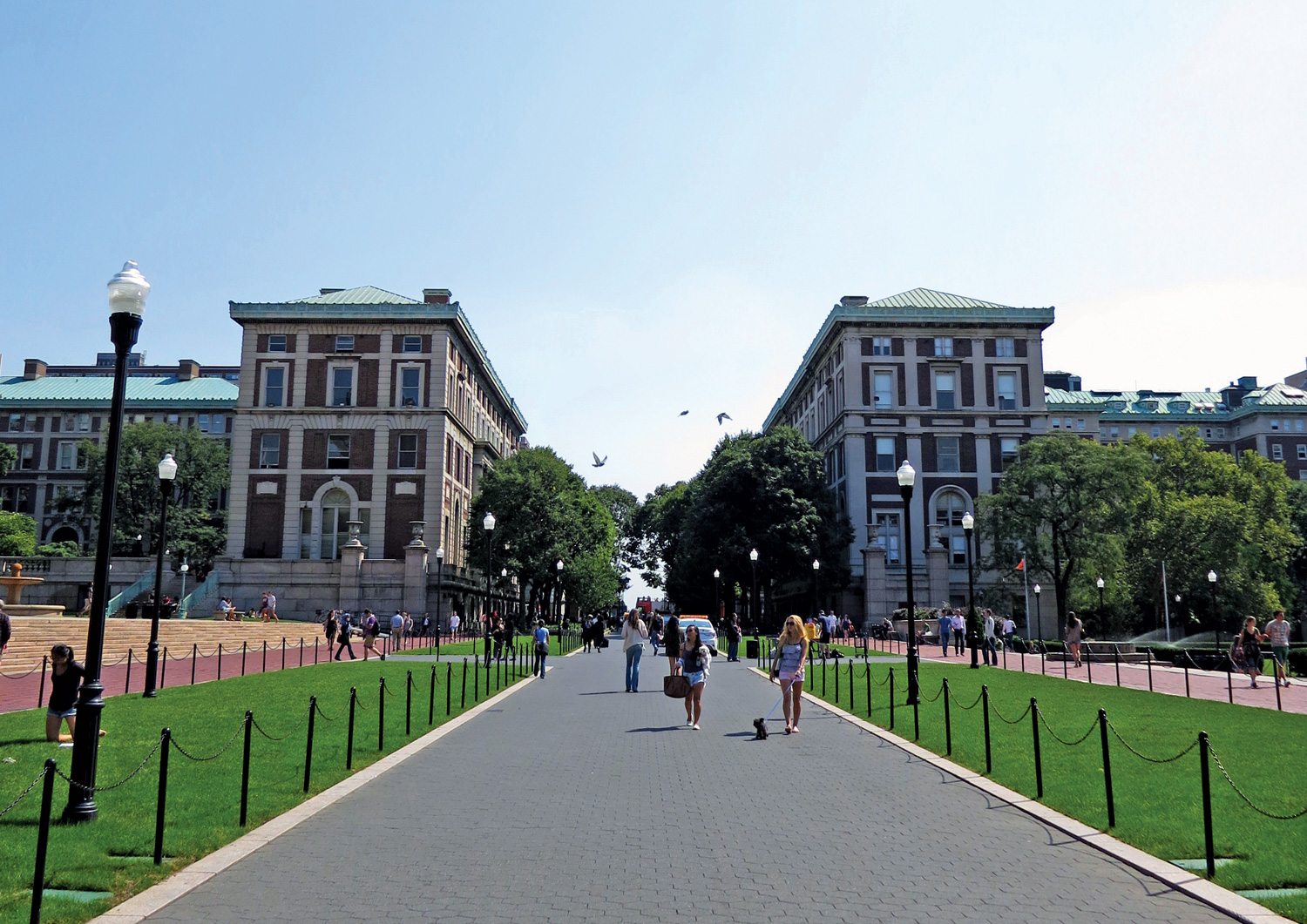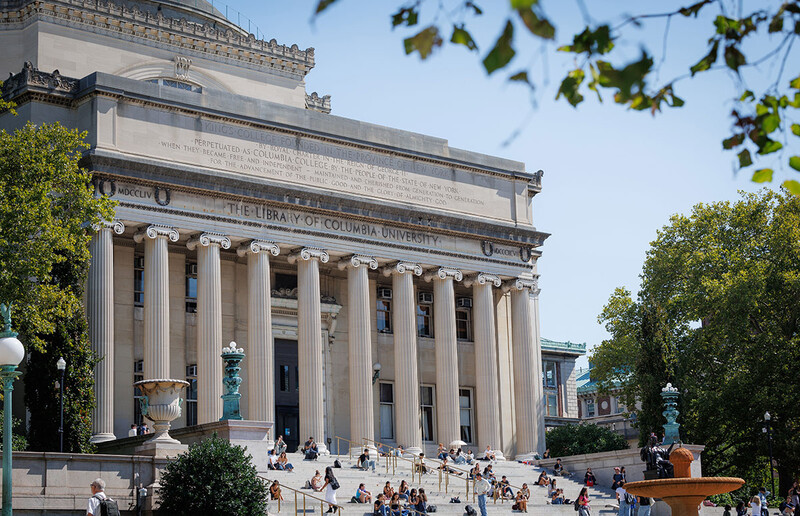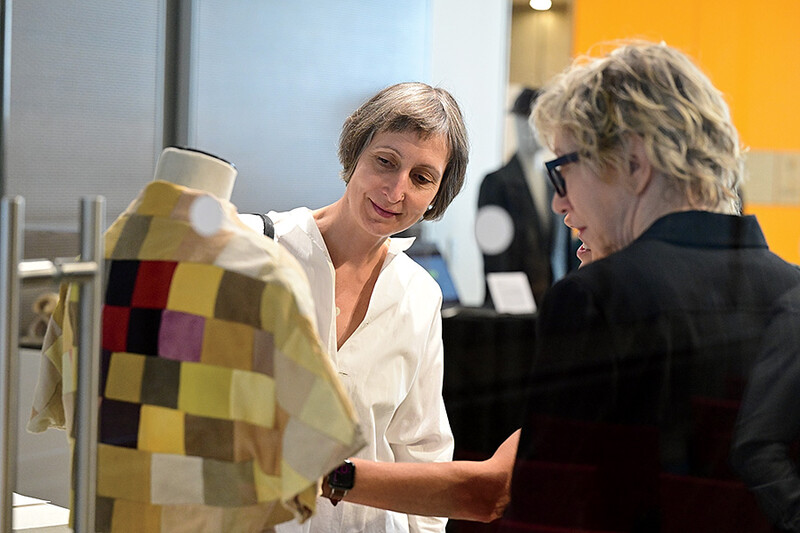How has Columbia changed in your decade as president — and in the four decades since you earned your law degree here in 1971?
This is a fundamentally different institution from what it was. Not because of me, but because of an enormous number of people who put in heroic efforts to build a sense of community and to work together toward achieving the greatness that’s the potential of this institution. Fundraising is a good indication. In the last campaign, which ran through the 1990s, Columbia raised about $2.5 billion over thirteen years. This summer we reached $5 billion in the current campaign. That’s twice the total in roughly two-thirds the time.
Columbia really did struggle from the late ’60s through the ’90s, and a lot of people put a lot of effort into trying to bring the University back. But in 2002 Columbia still had not been successful in bringing itself together as one institution instead of as a group of decentralized units. It simply wasn’t organized that way, and attitudes were not such that it could thrive as an institution. Individual parts might, but only for a fixed period, because it takes a whole institution to make a university successful.
It also takes a nuanced understanding of how a university needs to fit into its neighborhood.
There had been efforts to repair relations with the communities in Harlem, which were still incredibly stressed then and even hostile in the 1990s. That tension meant enormous things, including that Columbia couldn’t expand. It did not have space in which to grow to build academic programs, to find new ways in which to educate students, to bring in more students, to enlarge our intellectual reach. Without new space, universities wither. They don’t die, but they do become less than what they could be.
Over the past decade we’ve focused on our relationship with Harlem and on both managing the resources we have and bringing in new resources. We’ve worked on space, and the principal achievement there has been Manhattanville, a once-in-a-century opportunity to create an entire new campus that is equal in scale and potential to what the original Morningside Heights campus was to the University a hundred years ago. Almost eighteen acres, nearly seven million square feet, being developed over the next half century with a master plan by Renzo Piano. This fall you’ll see the first actual sign of our new physical presence as the steel for the Mind, Brain, and Behavior Initiative begins to emerge from the ground.
Please complete this sentence: “To be an educated person in the twenty-first century, you need . . .”
You need what you’ve always needed: a deep exposure to the great thinking, writing, art, and music of the centuries. Today, you also need to have a feel for the great issues that confront the world.
One of those issues is one with which you are closely identified. The US Supreme Court is scheduled to hear Fisher v. University of Texas at Austin on October 10. That case will look at the claim of a white applicant to the University of Texas who argued that she would have been admitted had the school not considered race as part of the application evaluation. If the court rules in her favor, Columbia and other colleges and universities across the country will lose one of their basic tools in ensuring a diverse student body. Are there still ways to make this work?
The answer is no. There is no other way to have the levels of diversity that we have come to value so much in American higher education and that have been so important to American society. If the court were to rule against the University of Texas, it might be on very narrow grounds. For example, some justices might think that the Texas diversity plan [which grants admission to all Texas high-school students graduating in the top 10 percent of their class] is not sufficiently attentive to characteristics of individual applicants to satisfy Grutter v. Bollinger, the 2003 case that upheld the use of affirmative action in the admissions policy of the University of Michigan Law School. Or some might wish to hold that a Grutter process cannot be added to the 10-percent program, as it was here, because it is not needed to supplement the diversity already achieved. You could imagine a majority of the court deciding that such a ruling would not impair the fundamental principle that the Supreme Court set down in Grutter.
As part of the amicus brief filed by Columbia and thirteen other universities in August, I advocated that the court uphold the lower-court decision allowing what the University of Texas has done. We are strongly on record for that.
But if a majority were to go the full distance, overruling the Grutter case and declaring that considering race under any circumstances, under any program in American universities is unconstitutional under the Fourteenth Amendment, it would have a drastic negative effect on racial and ethnic diversity on the leading campuses across the United States. All you have to do is look at what happened to Berkeley and UCLA since California’s Prop. 209 in 1996 to see the long-term negative effects of not being able to consider ethnicity in admissions.
Could economic diversity stand in for racial diversity?
There has been a view for a decade that you can achieve racial and ethnic diversity just by considering income status or economic and socioeconomic diversity. The argument is that you can try to get young people from the lower end of the socioeconomic spectrum and you will automatically get racial and ethnic diversity. But many studies show that this is not true.
Then some people say, if the Supreme Court were to throw out Grutter v. Bollinger, universities would find other ways to identify that the applicant was African-American, or Hispanic, or Native American. Universities would do what they could to achieve racial and ethnic diversity without appearing to consider race or ethnicity. My view is if the Supreme Court holds that the Constitution forbids admissions offices at universities from considering race or ethnicity, then no American university should violate that constitutional norm. That is the basic law of the country.
However much you might think the decision is wrong, you would undermine the integrity of society at its most profound level by trying to figure out other ways of doing what the Supreme Court disallows. And you’ll be caught, because years down the line, some group that opposes affirmative action will sue, and they will get documents showing what you were doing. Those universities would be justifiably embarrassed and ashamed.
It is too easy to think that striving for racial and ethnic diversity is such a powerful part of our culture that surely it will continue. But if the Supreme Court were to declare it unconstitutional, then it will not, and should not, continue.
In the majority opinion of Grutter v. Bollinger, Justice O’Connor wrote, “We expect that twenty-five years from now, the use of racial preferences will no longer be necessary to further the interest approved today.”
First of all, I had never known a Supreme Court case that gave a time limit to its holding. Second, my view has been that for decades, and even centuries, American admissions offices have considered many things in trying to put together student bodies that include people who have different life experiences and bring different talents to the whole community. You go back to statements by the early framers of the Constitution, who advocated that people from different parts of the country be brought together in university campuses. We do that. We take account of geographic diversity. We take account of diversity of capacities: some students are gifted in poetry, some in math, some in athletics. Some students have overcome great difficulties and have succeeded in some unusual way. We consider race and ethnicity along with lots of other things.
The issue is, how do we compose an incoming class of students? As long as we do so by looking at many factors, including race, the Supreme Court has so far held that we’re within our constitutional freedoms and rights. Columbia’s undergraduate student body is the most diverse among the top schools, and we’re proud of that. The undergraduate program at Columbia — the College in particular — is one of the most selective, one of the most successful, one of the most vibrant undergraduate experiences in the world.
What role does financial aid play in that?
In 2008 I announced that if your family makes less than $60,000 a year, you come free to Columbia College or the engineering school. That’s amazing. If you are entitled under our formulas, we will not expect you to take loans. We will give grants. This was a major reach for Columbia to build on the extraordinary financial-aid commitments that we have had for a long time. These are very generous terms, and they are consistent with the American ideal that the education of a young person should not depend on the wealth of his family or his circumstances; that it’s too important a pivot point in a person’s life to make wealth the determining factor of where one goes for an education and what kind of education he or she gets.
There are very few universities in the United States that live closer to that ideal than Columbia. Seventeen percent of the students in last year’s College and engineering undergraduate classes received federally funded Pell Grants, the highest number in the Ivy League. That is one sign of our commitment to socioeconomic diversity.
That still leaves a large percentage of students who either pay full fare or have to take out loans.
Yes, it is important to recognize that for someone who is not qualified for financial aid and pays the full amount, it costs a large sum of money to attend Columbia. I don’t mean in any way to minimize the number of students who graduate with significant loans and indebtedness. But the opportunities they will have over a lifetime because of what they received at Columbia make those burdens well worth that.
I work all the time trying to increase our financial aid, and I think we’re doing very well in that, thanks in large measure to the success of the campaign. We’re also trying to raise funds for those students, especially in the School of General Studies and the professional schools, who want to pursue careers in public service and need loan forgiveness in order to make those choices.
It is rare that you speak publicly without talking about globalization and its implications.
In the space of a decade, the world has become a different place. Anyone who has gone to China over a period of decades, for example, knows how much that country has done to change itself. The same goes for Russia, India, Brazil, and so on. The staggering change in the world is a result of the embrace of forms of capitalism and the flows of international finance, business, trade, and investment. This is the driving force of enormous transformation in the world, a transformation that is as great and as fundamental as any other age you can think of.
We have seen a near collapse of the world’s financial system. One of the things that has come out of that is a recognition that we simply do not understand how the world financial system really works. The resources of the world are finite, and the environment is under threat. What do we really understand about the policies that should be put in place? What about the global institutions that were created largely out of the Second World War era? Are they adequate to this new world? These are questions that people in law, political science, science, engineering, the humanities, and public health are facing, and universities need to explore them. As the world raced by in the past ten years, we have not adjusted fast enough. It is not in the nature of universities to move as quickly as the outside world does. We tend to think more deeply about problems, and that means that the time we have to adjust to a new world is different.
The graduate schools are notably international. What about programs for undergraduates other than a year abroad?
We have introduced an interesting certificate program called the Fifth Year, which will focus on globalization. A small group of students who have just received their bachelor degrees from Columbia College, Engineering, and General Studies will each select a global issue with a faculty adviser and then spend the first six weeks of the year on campus taking courses and seminars. They will spend the following six months working at different Columbia Global Centers to pursue research and attend lectures from leading political figures, people in business, and people in NGOs, and then come back and spend the last month or two at Columbia putting it all together in a proseminar. We hope that this may be as significant an opportunity for students and faculty to learn about the world as the Core Curriculum was a hundred years ago.
Have any of Columbia’s Global Centers had problems with academic freedom similar to the troubles that NYU has faced at its campus in Abu Dhabi?
Not in any significant ways. The world is a complicated place, and there are few countries with exactly the same value system as the United States. You have to start from the premise that if you’re going to be out in the broader world, whether with a branch campus or a center or some kind of program, you are going to be in societies that have policies, laws, practices, and customs that are contrary to those that we subscribe to in the United States.
As a beginning proposition, our understanding of the world depends upon our engaging with the world, even in places that are in conflict with our values. The alternative of retreating to your own base or your own country and not engaging with the broader world is a mistake. Every other institution, whether it’s our government, foundations, or business, has taken the path of more engagement rather than less.
The types of things universities do will pose different risks. Setting up a branch campus in places that do not value or respect academic freedom or freedom of expression is more dangerous than setting up a center that is lightly funded and not engaged in bringing in a student body and having a resident faculty. If you had a branch campus and the order came down from a government, “You shall not teach this subject because it might incite students to disrespect the government,” I think no self-respecting American institution would say, “Fine. We acknowledge that and we will conform.” There are some things we simply cannot tolerate.
With a major investment like a branch campus, you are at risk of very big costs of withdrawal, and that is one of the reasons why we have chosen to go the simpler route of Global Centers. In our case, we still have to work out the parameters for ourselves about what we will and will not accept in the way of limitations. But up to this point, we’re feeling good about the role the centers can play. Of course we also are trying to play a productive role in bringing the values of the United States and of American higher education to places that are less accommodating to it.
Of course everything comes down to this: What are we trying to do with the Global Centers, on Morningside Heights, and on the new Manhattanville campus? What are we trying to accomplish with our great missions of research, new knowledge, preserving knowledge, and educating the next generation of students? It is difficult for us to imagine just how great Columbia can be. That may sound strange. But almost every day I spend some time trying to make sure that I haven’t underestimated just how much this place is going to accomplish.



